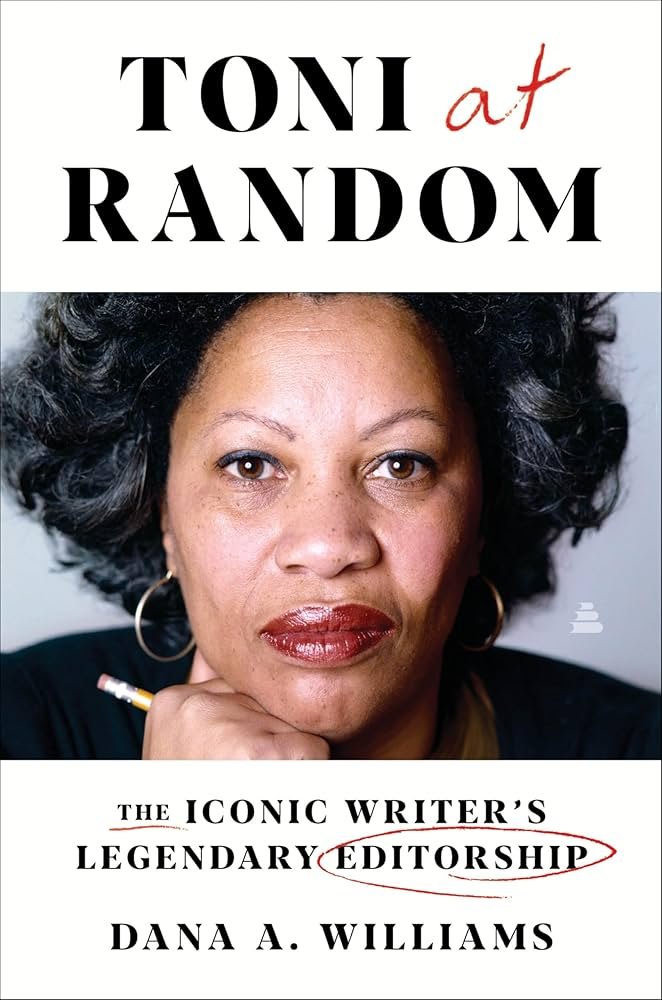An Opening: On Toni at Random
by JAHAAN SHAHEED and JOSH MYERS
in Spring 2025
Jillian M Rock, “centralforces,” 2022
Eighteen years ago, we ascended a mountain. The summer after our sophomore year of college, a group of us traveled to South Africa, shepherded by Dr. Dana Williams. That time, and a subsequent trip to Egypt a year later, was formative. Bound by collective inquiry, what we learned has never left us: the work that we all must do is great but far from daunting. It is possible.
We did not know it then, but Williams was working on Toni at Random: The Iconic Writer’s Legendary Editorship (2025) at the time we first met her. We did not know it then, but she was also giving us something that had been carefully given to her. That care comes through in the ways she guides readers through Toni Morrison’s editorial career with precision that enables insight, intimacy that warrants reverence, and familiarity that invites reflection. Every morning during our trip to South Africa, when she had us free write, she was modeling the same commitments that guide her caretaking of this tradition. As she read our writing, it was as if she saw more in us than we had ever imagined. We were being initiated. And her work of crafting a narrative on Morrison was being shaped through a common relationship and bond that knitted us together, even in those moments when we did not know what it meant. Williams taught and modeled we all we got. So it was appropriate that this framing constitutes the initial chapter of Toni at Random.
The result of all this labor is an intellectual tour de force. The writing itself is a gift, a form of address that felt as direct and urgent and as open and considerate as we know Williams to be. But this is more than just craft. The way you tell a story of Toni Morrison’s life and editorship demands this kind of approach. The reader feels invited in, but we also sense that there is a responsibility now that you know. Kind of like being one of Williams’s students.
In Toni at Random, we learn that the mid-twentieth century renaissance of Black women’s writing had at least one insider, working to represent the depth of Black ideas on an often reluctant publishing establishment. Perhaps Morrison did not change that industry. But she did help authors get published by a major house, many of whom might not have otherwise been given a shot. Williams handles these stories with care, offering less an academic theory of editorship and more of a story of how Black artistic and literary interests and camaraderie runs up against the political economy of a white industry. If Morrison is associated with that moment of renaissance, we might do well to understand with Williams what it meant for her to help champion the ideas of everyone from Chinweizu to Nettie Jones, alongside the more well-known Toni Cade Bambara, Angela Davis, Huey Newton, and Muhammad Ali, all writers who believed in revolution in one way or another.
Many of the books that Morrison edited were not deemed commercial successes. So perhaps it might call us to question what it might mean to have a renaissance when the most experimental and invigorating aspects of that moment never achieved the critical and popular attention that Morrison might have envisioned? And what might this all mean now, when murmurings of a renaissance are back, and the publishing world has an appetite for Black writing again? We might read Williams’s Toni at Random with these questions in mind.
So we thought it appropriate to get the ball rolling by commissioning this forum. In her essay, “Migration, Word Work, and Collectivism: On the Interdisciplinary Artist-Editorship of Toni at Random,” writer, artist, and womanist cultural worker Constance Collier-Mercado interrogates the ways that Morrison’s itinerary and artistic interests helped shape what eventually becomes the important documentary work of The Black Book. Using Williams’s work, Collier-Mercado argues that Morrison was able to land on this work of preservation through the many sites where she engaged and found Blackness resonant. Morrison’s interests as an artist are not separate from her list as an editor. In “Black Books Were Here Business: Toni Morrison and Black Men Fiction Writers in Toni at Random,” poet, storyteller, and filmmaker Julia Mallory engages the significance of Morrison’s editorship of novelists like Leon Forrest and Henry Dumas. Taking care to examine Williams’s reading of the editorial approach and potential controversies involved, Mallory’s essay demonstrates the importance of Toni at Random’s exploration of Morrison’s eye for both talent and literary significance within the literary sphere. Finally, A Gathering Together editor Josh Myers excavates the formation and critique of the literary canon through Morrison’s editorship of writers Toni Cade Bambara and June Jordan. In “Canon-Making and Unmaking,” Myers explicates Williams’s representation of Morrison’s literary friendships and the commitment to the story and to craft and what it had to with the issue facing Black folk (as both Bambara and Jordan put it).
Tribute requires that we return, that we pay attention, that we remember who helped us think deeply. In this issue, tribute is both subject and structure. It is the connective tissue between Toni Morrison’s editorial vision, Williams’s teaching practice, and the existence of this journal.
Jahaan Shaheed and Joshua Myers are editors of A Gathering Together: Literary Journal.


